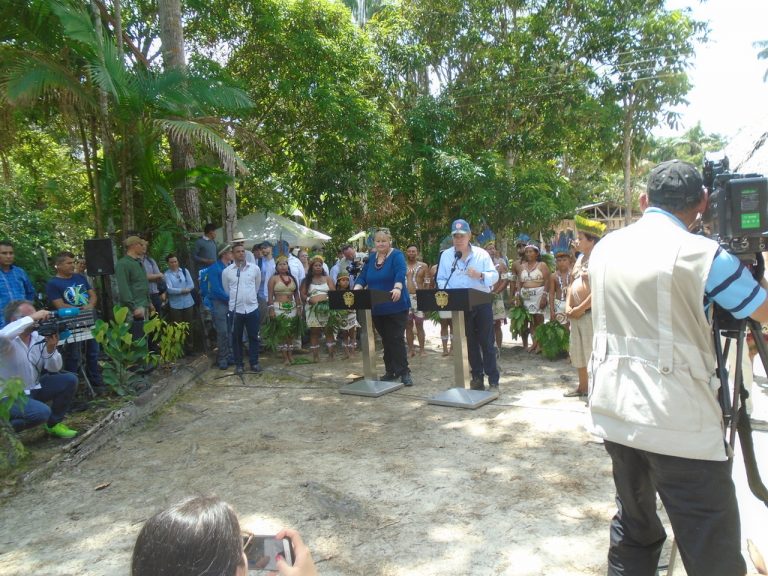On Tuesday 10th April, 30 years after indigenous communities in the Colombian Amazon received legal title to their lands, the government has signed a decree that ensures local governance over their territories.
“This is the most important thing that has happened to the indigenous Amazonians in 30 years,” said Martin von Hildebrand, founder of Gaia Amazonas, who has devoted his life to the protection of the Colombian Amazon, working for over 45 years alongside indigenous groups for the recognition of their rights.
In the Amazon city of Leticia, Colombian President Juan Manuel Santos signed a Decree of Non-Municipalized Areas, in the presence of local indigenous leaders, and accompanied by the Prime Minister of Norway, Erna Solberg.
The decree strengthens the autonomy of indigenous peoples of Guainía, Vaupés and Amazonas, three political-administrative departments of Colombia’s Amazon region. It effectively allows indigenous communities, through their Associations of Traditional Indigenous Authorities, to execute and administer state resources, without intermediaries, and was welcomed widely by local indigenous leaders present at the signing of the decree:
“Right now, we are content because we will have a legitimate autonomy and self-government. It is a recognition by the government of our fundamental rights”, said Libardo Bolivar Martín, from the Tatuyo ethnic group.
“This decree is an opportunity for us to govern our own territory with our own policies; and we now have a responsibility with the state for the administration of state funds”, said Guillermo Rodriguez Macuna of the Association of Traditional Authorities of Pirá Paraná River (ACAIPI), Vaupés.
“We are very pleased. This is a step forward that we have been fighting for over many years, and the responsibility going forward is now in our hands, and we are organised to administrate education, health and our own system of governance”, said Felix Matapí of the Association of Indigenous Captains of Mirití Amazonas (ACIMA), Amazonas.
“This is an historic moment for us. This decree is a legal instrument that relates to our autonomy and decentralisation. This regulatory decree is also important for the defence of our territory and biodiversity”, said Dario Silva Cubeo, of the Indigenous Association of La Pedrera Amazonas (AIPEA), of the Lower Caquetá River, Amazonas
This historic decree is three decades in the making. In 1988, the Colombian government of Virgilio Barco made a historic move in returning more than 18 million hectares of Amazon territory to indigenous communities – a figure that has since increased to more than 26 million hectares. Another important step was taken in the 1991 Constitution’s recognition of Colombia as a multi-ethnic and pluricultural nation. However, while the Amazon was divided into political-administrative departments and municipalities, the indigenous territories remained ‘non-municipalized areas’ – 37.6% of the Colombian Amazon did not have a local government, or at least not one which was formally recognized.
During the signing ceremony, President Santos acknowledged the fundamental role of indigenous peoples as guardians of the environment and explained that they are the ones “most interested in conserving their forests, in conserving their rivers, in not contaminating, they are our best allies; that is why it is very important to see their autonomy, which today we give them, with the preservation of our environment.”
President Santos also referred in his speech to von Hildebrand´s work as being instrumental to this decree for indigenous groups of the Colombian Amazon to govern their lands, according to their worldview and customs; and being persistent in explaining how strengthening the governance of these ethnic groups is key for protecting the forest.
This new decree is a major part of President Santos’ governmental plan to safeguard the Colombian Amazon, which includes expanding Chiribiquete National Park by an additional 3 million hectares to establish limits for the agricultural frontier and colonisation.
Colombia can now claim that 85% of its Amazon territory is under some form of protection. That fact, alongside the recent ruling by Colombia’s Supreme Court of Justice on the Amazon as being subject of rights, and the peace agreement reached with the FARC guerrilla, are important steps for a better world, for future generations.
For more information, contact:
Martin von Hildebrand*
Mobile: +57 313 8548658 / Email: mvhildebrand@gmail.com




